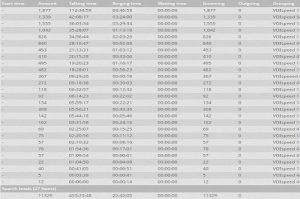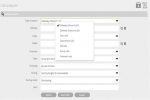VOIspeed UCloud provides reports on the usage of the phone system that can be sent to you by email at regular intervals (i.e. numbers of calls received or lost, average talk time and how long a customer has been kept on hold before talking to an agent). In the administration interface, you will be able to access the Call Reporting section, where you will be able to run an advanced analysis of calls routed via the PBX. In the same section, you can then set the report as a template to be sent as an attachment by email at regular intervals (e.g. daily, weekly, monthly).
Using all the available filters, you can then create complex reports that will give you the option to better adjust the use of the phone system and its capabilities making sure all calls are routed in the correct way and no calls are lost.
The call analyzer’s objective is to search all calls using the same criteria.
The main filter is composed of seven different options.
Type of search
- Gateway inbound calls: incoming calls
- Gateway outbound calls: outgoing calls
- User calls: calls made or received by a particular user
- Department: calls made or received by a particular department
- IVR calls: incoming calls going through the automatic responder
- Group Calls: calls received by a particular ringing group
- Voicemail calls: calls received on the company voicemail
- Caller: you can select contacts from the centralised phone book or number to find a particular number. Also you can use the symbol % to search a particular prefix. For example if you are looking to filter all mobile calls you will need to enter “%074”.
- Outcome: group of calls with same outcome (ok, busy, rejected, unreachable, no response, resources unavailable, do not disturb, absent, timeout)
- Date: to select when the calls was made or received: today, since last week, since last month or a time range.
- Grouping : if you leave this option blank the call analyzer will display calls with all details. Consider that processing this request will require considerable processing power (as SQL query) and therefore it is not recommendable to run it during the day…
- By search item – calls are grouped based on the type of search
- By calling number – calls are grouped based on the calling number
- By number called – calls are grouped based on the destination number
- Sorting:
- Sort by call beginning time – older calls are displayed first
- Sort by quantity – telephone numbers that are dialled (or that call in) more frequently are displayed first
- Sort by length of conversation – calls are sorted based on the length of conversation
- Sort by length of ringing time – calls are sorted based on the time the phone was ringing
- Sort by waiting time – calls are sorted based on the waiting time (i.e. on hold)
- Sort by number of incoming – calls are sorted based on the number of incoming calls
- Sort by number of outgoing calls – calls are sorted based on the number of outgoing calls
- Sort by grouping – calls are sorted based on the grouping type
- Sort by calling number – calls are sorted based on the calling number option
- Sort by number called – calls are sorted based on the called number option
- Limit– you can set the number of records returned by the query
Once you set the query you can save it as a template and run it again in future






